Swansea and Llanelli see biggest M4 traffic rise
Motorway congestion is by no means solely a Newport issue. West of Swansea has seen the biggest increase in M4 traffic - up 78% since 2000.
Although fewer vehicles are on the motorway there than around Bridgend, Cardiff and Newport, official figures highlight an unprecedented rise in west Wales.
Commuters speak of increasing queues and residents complain that public transport options are too limited.
Meanwhile there are worries that the potential of thousands of new homes off the motorway will add to problems.
Transport expert Mark Barry said the issues were a "brake on the economy" of Swansea Bay and suggests a re-think of city deal priorities to improve connectivity.
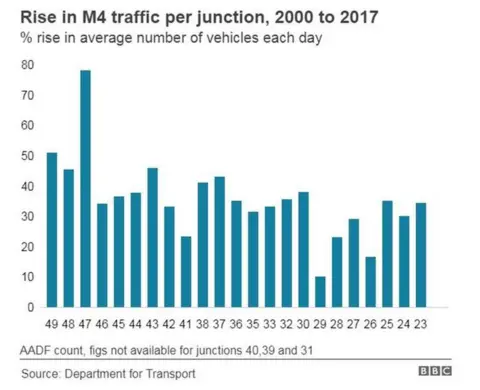
The five M4 junctions in Wales which have seen the biggest increases have all been west of Port Talbot, according to Department for Transport figures.
Junction 48 has seen a 45.5% increase in traffic. In the morning peak hour, more than 2,000 vehicles pass through junction 47 heading east.

But could it get even worse?
At Penllergaer, south of junction 47, the Parc Mawr development would be one of the largest in Swansea for years, potentially involving 850 homes over nearly 80 acres.
Local councillor Wendy Fitzgerald is worried an extra 17,000 houses envisaged across Swansea could put even more pressure on the area.
She said a transport solution needs to account for the fact people work along the whole of the M4 corridor, not just in Swansea.
Concerns about congestion are not confined to the M4, she explained, but the roads off junction 47 and people living beyond Penllergaer.
She said: "I've honestly no idea what the solution is, if all the housing that's planned goes ahead."
Wyn Morgan has lived close to the motorway for 30 years. He believes the development could double the size of the village - and only add to the congestion.
"We were told in 2007 that junction 47 was beyond saturation then," he said.
Swansea council said highway infrastructure improvements are a "key part" of the local development plan - which aims to create more than 13,000 jobs.
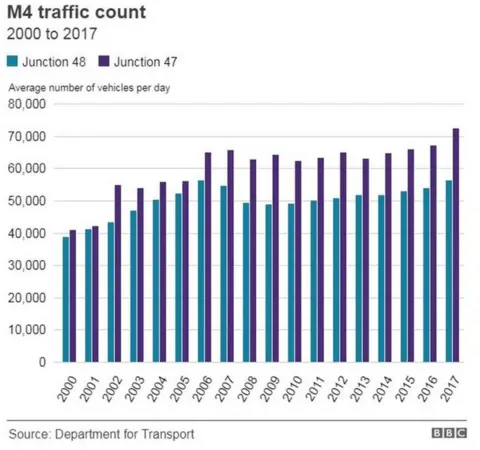
Similar issues are being experienced a few miles west, off junction 48.
Kate Reed has lived in Llangennech, Carmarthenshire, for nearly 20 years and commutes east along the M4 to Swansea.
"On the way home I try to skip the traffic and leave by 4pm," she said.
"If I leave at 5 it's really bad. I wish I could work from home more."
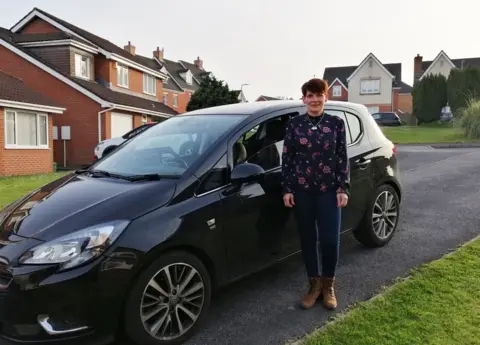
When Elin Oliver and her husband Jeremy bought their house in Llangennech, there were just fields nearby. Now there are three housing estates opposite and more on the drawing board.
"There are lots of people who have chosen to live in Llangennech because of its access to the road network. But because of that its taking much longer to get out of the village and onto the M4 than is used to," she said.
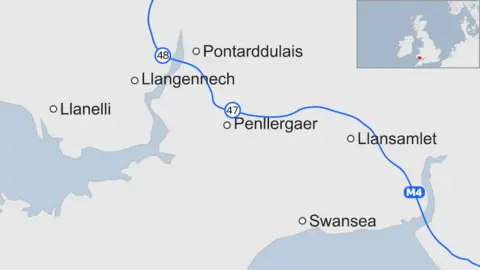
Kelvin Williams, 58, commutes 12 miles a day along the M4 from Pontarddulais. He said junction 48 is an "accident waiting to happen" with the back-up of cars trying to leave for Llanelli and Pontarddulais.

What about alternatives?
"There's no way the motorway can be widened along the corridor; that's out of the question," Mr Williams said.
He added there is no direct route by train to get to work, and would need to go via Swansea to use the bus.
Emma Heyes faces a three-hour round-trip from the outskirts of Llanelli to Cardiff, where she works for insurance company Admiral.
"I love living by the sea and that's why I put up with the commute," she said.
"There's a big patch from Penllergaer right through to Port Talbot - and that's the worst bit, it's a slow crawl, bumper-to-bumper.
"Every now and again I say I'm going to try the train - but it's expensive, overcrowded and more often than not you have to go to Swansea and wait for a connection."
According to analysis by the Centre for Cities, Swansea has one of the lowest proportions of commuting by public transport in the UK - just 6% travel by bus or train.
Underperforming
The city centre is currently underperforming and has a lot of potential to do better, according to Simon Jeffrey, policy officer at the think tank.
"It's highly likely that putting people's shopping out of town and new employment out of town, you make the city centre less attractive for knowledge-intensive jobs," he said.
A new West Wales Parkway railway station near the old Felindre tinplate works has been proposed, with parking for 500 cars. The line currently only runs two passenger trains a day.
But Prof Mark Barry, of Cardiff University, believes that would work best as part of a wider vision of a commuter rail link.
He has proposed a Swansea Metro and thinks as a first phase, something imaginative could be done in the next five to 10 years to feed into the city centre.
One of his suggestions is upgrading the existing Llansamlet station. He argues it would help ease congestion and help jobs, wages and living standards.
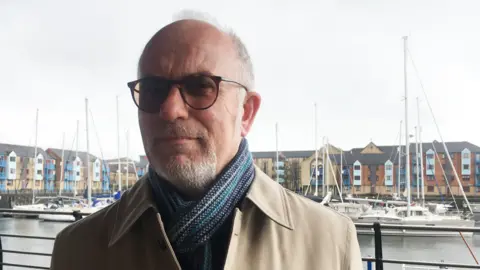
"We've got the Swansea district line, which traverses Swansea and Neath - if we can link that line to the main line somewhere, you could then potentially introduce stations at Felindre, Penllergaer, Morriston - and offer a service that gets you to Swansea High Street," he said.
Prof Barry believes the transport network currently is a "brake on the economy", pointing to the lack of a dedicated commuter rail network between Port Talbot and Llanelli as an example.
"Swansea Bay has become very reliant on the car with consequential impacts on congestion, less than optimal developments, air quality and carbon emissions," he added.
Bottlenecks
Rob Stewart, Swansea council leader said there needed to be investment in the M4 corridor in Wales, "but not all in one place", such as was planned for Newport.
Mr Stewart believes widening the M4 around Port Talbot and improvement to Fabian Way in Swansea could help congestion.
He said these places are "bottlenecks" and work is needed with the Welsh Government and the UK government "to address them in ways which will help improve the economic prospects" of the area.
He also called for financial support for a south west Wales Metro, to connect communities and encourage people to get out of their cars and use public transport.
